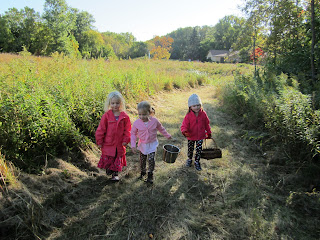Melanie Grue and I had the good fortune to attend and present at the National Association for the Education of Young Children’s Annual Conference in Orlando this November (thanks Marty & Jason!). Our own presentation was very well received, and attended, despite the fact that we were scheduled at 8 am in the very farthest flung room in the 2 mile long Convention Center. People really had to want to get there, and they did.
Well, participating in a conference can be a little crazy-making (and I don't know about you, but Orlando makes me appreciate the natural beauty of Minnesota) but fortunately we walk away with new connections and a few “aha moments.” I don't know about you, but I need a little quiet time to think, and the older I get, the more I like late autumn, as it engenders rumination. I’m speaking of the quiet time, after the “noise” of fall color and activity. After the rush to enjoy the sights of the season, after we bring in the harvest, celebrate the bounty and generally live it up, there is a still moment or two to breath. Before the holidays and the snow, and more snow, the woods are bony and bare. Leaves have leached their color. Deer are easier to spot. Everything is reduced to its essential elements, no distractions.
As I admire the quiet, monochromatic beauty of this spare season, I recall a NAEYC session we attended right before we jetted back to Minnesota. “One of the Hundred Languages of Children,” was a literacy presentation given by Lella Gandini and Amelia Gambetti of Reggio Emilia fame. These Italian educators shared footage of children drawing and writing at a table, talking and being silly together. They argued about letters, in Italian: “That is not an “L.” An “L” is a leg. Like this. Here!” The indignant child, across the table, was seeing his friend's letter upside down, thinking it was all wrong, which was funny (even funnier in Italian), but what was more interesting, was his connection between something physical—a leg—and a symbol. A symbol is a metaphor, a stand in for meaning. I recall a little Dodge kid running to an orienteering post in the woods and exclaiming to a friend, “K! K starts with Kendall!” I corrected my student's word order: “Kendall starts with ‘K’.” But, in the child’s experience, ‘K,’ the understanding of the symbol “K,” starts with herself. Kids take a concrete experience and then create a metaphor for the experience to create language. Experience gives kids language. It occurs to me that we educators and parents sometimes “can’t see the forest for the trees,” when we consider literacy. We ask, “Where is literacy in the preschool classroom?” We think about little Johnny sitting down to trace letters in quiet consternation. Is this how he acquires language? Is this even developmentally appropriate? Something much more basic and elemental drives little Johnny and his friends to acquire language: the community of the classroom. All the buddies together, with their teachers, a forest of children, growing together—this is what grows literacy.
As young children seek the companionship of peers, as they strive to make friends, they must learn to communicate. This drive to know others, and to be known, to communicate, is what fuels the need, and desire to acquire language, and language skills. How do children begin to do this? Where do we see literacy emerging? Why, in collaborative play, of course! Children play House, chatter on pretend phones, ask for and share items, take turns talking, express themselves non verbally in drawings, scribbles and “secret messages.” They work to sign a painting, seek and make eye contact, ask for hugs, shout or express frustration or tell a teacher they need to use the bathroom. They work so hard to make themselves and their needs known in the community of the classroom.
Where is literacy? Everywhere! It is even in the climbing, running, jumping, dancing, skipping and general mucking about that they do with their bodies; physical play is building motor dexterity and shaping a brain that can put pen to paper, form letters and begin to make language from left, to right, for the rest of their lives. Literacy is in the fundamental, bare bones child work of play.








































